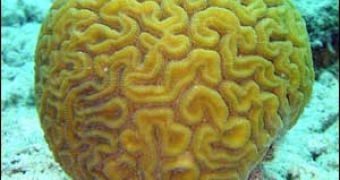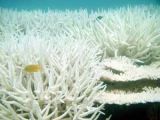That's the clearest seawater, a crystal clearness increased by the white sand. A coral reef is like a sea rainforest.
Corals are colonies made up of polyps, small animals with a maximum diameter of 2.5 cm (1 in). The soft polyp is linked to its neighbor through living tissue covered by mucus. During the day, the corals look like stones, because the polyps retire into their skeletons. During the night, the spread tentacles of the polyps swing gently, giving the reef a soft, fluffy look. The stony "tree" in which the polyps live is a combination of their skeletons, cemented by calcium carbonate (limestone) extracted from the seawater.
There are about 350 species of reef making corals, amazing through shapes, sizes and colors. The coral branches may take various shapes, from moose or deer antlers, to trees, columns, tables, umbrella, mushrooms, as their names suggest. There are also lattice, carnation, strawberry and even brain corals (Meandrina).
The 'jungle' of the coral reef harbors from microscopic animals and algae to sea lilies, octopuses, sponges, shrimps, lobsters, snails, starfishes, rays, sharks, moray eels and turtles. The reefs are to the sea like rainforest on the ground: they harbor the highest marine biodiversity, thus the highest number of fish species: thousands of species in the worldwide reefs. There are fish groups restricted to corals, many weird or extremely beautiful, including damselfishes and clownfishes (Pomacentridae), Moorish idols (Zanclus), trumpetfishes (Aulostomus), triggerfishes (family Balistidae), which have evolved an original defense system linked to life in the reef: three spines, which when fixed into the coral, a predator must break the coral to get to them, the surgeonfish (family Acanthuridae) with sharp caudal spines, real scalpels, on each side of the tail; the filefishes (family Monacanthidae) with abrasive skin; lionfish or turkeyfish (also known as firefish or scorpionfish) (Pterois genus) with long venomous spines, the stonefish (family Synanceiidae) perhaps the most dangerous fish of the reef: they possess the most powerful venom amongst all fish species, an extremely toxic neurotoxin, which is deadly to humans and mimic rocks by color and form; the batfishes (family Ogcocephalidae) which look like tadpoles and can walk on the bottom of the ocean in a toad like style; the porcupinefishes (the family Diodontidae) with well-developed sharp spines covering body and which can inflate their body (by swallowing water or air); the butterflyfishes (of the genus Chaetodon) with a spot imitating an eye at the base of their tail; the boxfishes (cowfishes) (family Ostracionides) with the body enclosed in a bony carapace with a honeycomb model.
The coral reefs form the largest biological structures on Earth. The Great Coral Barrier off northeastern Australia is 2,010 km (1,200 mi) long and covers the surface of England and Scotland united. A coral can weigh a few tones and raise 9 m (30 ft) over the sea bottom. Coral reefs grow only in tropical seas, no deeper than 60 m (200 ft). The reefs require an environment poor in nutrients, explaining the clear water in a reef.
The polyps hunt small animals with their tentacles but they also live in symbiosis with algae called zooxanthellae that make photosynthesis, that's why the corals live only in lighted places. The photosynthesis products of the algae are eaten by the polyps and their waste products are used by the algae to synthesize biochemical compounds. The healthy coral is brown, green, red, blue or yellow. The symbiosis with the algae allows the corals to live in tropical nutrient-poor waters.
As they need light, current and warm waters, between the coral species there is a strong competition for space. Even if corals live fixed to the sea bottom, between two colonies that live very close to one another sometimes fierce "battles" can be triggered for space and food supply. The species is named the fire coral (Millepora alcicornis), an extremely aggressive one living in calm waters under a depth of 10 m (33 ft); if it detects the presence of another coral in a range of 30 cm (1 ft) around, it will kill it.
Special ramifications which have an odd hand shape travel centimeter by centimeter, in a few months, the distance till the neighboring colony, sneak amongst its branches, fix on them and suffocate them. The offensive coral does not touch algae, sponges or other Millepora. The fire coral attacks especially the splendid Gorgonia species, with a varied color pattern. The aggressor attacks only if its "rival" is placed upstream to the current.
Specialists believe Gorgonia releases a chemical, which by the water current, is detected by Millepora, which develops faster on an already built coral skeleton.
The fire corals are the most dangerous for scuba divers as in contact with the human skin, they provoke an intense, even if short pain but also reddening hives and itches. Defensive cells, called nematocysts that go off, penetrate the skin with some microscopic harpoons which inject venom. If the contact is made with a smaller animal, this can be paralyzed or killed.
Biologically, the reefs are considered the most productive underwater ecosystems. Reefs also form a barrier between the waves and the shore and form foundation for thousands of tropical islands.
Still, corals are very fragile. They can be broken off by hand. You can imagine the effect of ships chocking to corals, or anchoring on a coral area. But the greatest danger is posed by chemical contamination, oil spill, wastes, fertilizers, sediments and infiltration of freshwater. When stressed, the corals spit out the algae (which are immediately eaten by the fish) and if the process persists, coral death (bleaching) installs. Today, bleaching is extended worldwide and fish and other species are gone. Coral bleaching used to be periodic and isolated. Now it has planetary proportions.
Over 10 % of the world's reefs have been destroyed by human activity. By 2030, 60 % of the world's reefs could be gone in 93 countries. Only remote reefs are really healthy. Destroyed reefs are encountered in Japan, Taiwan, Philippines, Indonesia, Singapore, Sri Lanka, India, Kenya, Tanzania, Mozambique, Madagascar, Haiti, Cuba, Florida, Jamaica, Trinidad, Tobago. Overcrowding and development in those areas spurred the phenomenon.
Corals breed between 25 to 29? C, but 1-2? C over these values can be deadly. Global warming seems to pose a great threat for the corals.
In 1983, 95 % of the corals off the Pacific coast of Central America died. A less powerful bleaching occurred in central/western Pacific, Great Coral Barrier, Thailand, Galapagos, Bahamas, Columbia, Jamaica, Texas and Puerto Rico.
Some link the coral death to the thinning of the ozone layer, as corals would be somehow sensitive to ultraviolet light. Also, CFC that destroys the ozone layer is not only going to persist for 100 years, but it is 20,000 times more powerful than carbon dioxide in inducing the greenhouse effect.
In developing countries, residual waters are drained into the sea without any treatment. Reefs are destroyed and mined. In Sri Lanka and India, whole portions of the reef have been covered in cement. Ships also destroy many reefs through anchoring or contact. Plastics, aluminium cans, fishing hooks and glass bottles are indestructible, polluting the reef for long.
Anyhow, if the forecast global warming means a temperature rise of 3-8? C in the atmosphere, this will doom the corals. Paradoxically, the corals' disappearance will increase global warming, as they consume a lot of carbon dioxide for building the calcium carbonate skeletons and their deterioration will speed up the process that destroys them.

 14 DAY TRIAL //
14 DAY TRIAL // 
